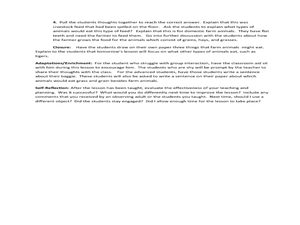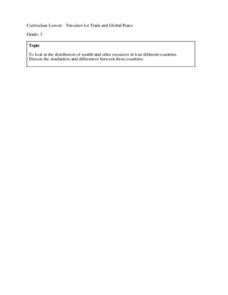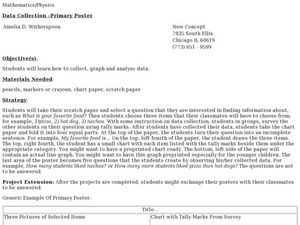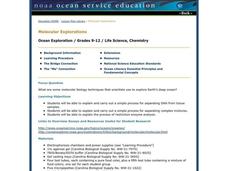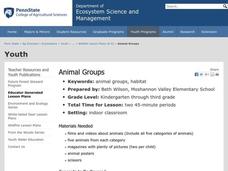Curated OER
Choosing a Career in Health
Students describe the role of hand washing in prevention of disease transmission, explore various careers in the health field, and describe a health career that is of interest to them, and explain why.
Curated OER
Who Will Benefit if We Give Bulbs What They Need to Grow?
Students identify the elements needed for bulbs to grow. They raise tulips and give them to various members of the community. They identify local philanthropic communities and look for ways they can constructively donate time and give...
Curated OER
The Science of Glaciers
Students identify the contents of a glacier like those found in Patagonia. They construct a mini glacier model in class. Students compare and contrast the classroom model with Patagonian glaciers. They label specific parts of the...
Curated OER
Calculating The Poverty Line
Young scholars examine the poverty line. In this poverty line activity, students discover what the poverty line is and how the U.S. government determines it. Young scholars calculate alternative poverty lines and examine their implications.
Curated OER
Homogenous and Heterogeneous Mixtures
Fourth graders explain and describe what a mixture is, distinguish between the two types of mixtures (which are heterogeneous vs.homogenous) and are able to create and appropriately label mixtures.
Curated OER
What's Happening in My World?
Students look for examples of chemical and physical changes in the world around them and complete "What's Happening in My World" worksheet.
Curated OER
Hunger and Your Community: The Drive
Students identify ways to contribute to their community. In this philanthropy lesson, students examine hunger facts and figures. They identify ways hunger, poverty and issues of poor health might be addressed. Students determine a...
Curated OER
Estimating and Counting Money
Students explore the concepts of estimating and rounding. In this estimating and rounding lesson, students play a game of tic-tac-toe. Students pick items and must estimate their cost by rounding. Students estimate the costs of pretend...
Curated OER
Sweet-Talkers
Learners investigate what is being sold to them. In this media awareness lesson plan, students visit selected websites to take a closer look at advertising marketed at them. Learners discuss the implications of marketing geared toward...
Curated OER
Biological Succession in a Microecosystem
Young scholars investigate the concept of biological succession by simulating the process in a microenvironment with various microorganisms. By engaging in a lab, students determine the factors causing succession and learn population...
Curated OER
Chemical and Physical Changes
Young scholars experiment, identify and apply the concepts of chemical and physical changes utilizing real-world examples. They discuss and model physical and chemical changes, answer guided questions and play a game that reinforces the...
Curated OER
The Living Environment
Students explore the cycles of an ecosystem. In this environmental science lesson, students work in groups to research the nitrogen cycle, the water cycle, or the oxygen-carbon dioxide cycle. Students prepare a PowerPoint or other...
Curated OER
Beaver Ecology
Learners explore the lives of bgeahvers. They identify the physical and behavioral adaptations that help beavers survive in their environment. Students compare and contrast how beavers influence the ecology of both forest and aquatic...
Curated OER
Seed Plants: Gymnosperms
Students identify what makes up a seed. In this gymnosperms lesson students identify conifers and explain how they reproduce and what the importance of gymnosperms are.
Curated OER
The Electric Sieve
Students examine different mixtures and how they can be separated. In this electric sieve lesson students complete an activity that allows them to separate mixtures.
Curated OER
What's in it and Who Eats it?
First graders explore farming by illustrating images. In this livestock activity, 1st graders discuss what types of plants are used to feed livestock animals and how pets and humans eat the livestock animals. Students draw images of what...
Curated OER
What's My Number?
Fifth graders use AppleWorks to stamp a given number to the thousandths place. They read, write and order integers, whole numbers and rational numbers. They represent place value using concrete or illustrated models.
Curated OER
Travelers for Trade and Global Peace
Learners explore the resources in other countries. In this communities lesson, students examine characteristics of their community to those of other communities. Learners examine Canada, El Salvador, and India and their natural resources.
Curated OER
Data Collection - Primary Poster
Students explore the concept of collecting, analyzing, and graphing data. In this collecting, analyzing, and graphing data lesson, students create a survey about a topic of interest. Students poll their classmates, analyze, and graph...
Curated OER
Blasphemy: Salman Rushdie
High schoolers discover the definition of blasphemy and examine examples of it in history. In this blasphemy instructional activity, students listen to their instructor present a lecture regarding details of blasphemy throughout history....
Curated OER
Molecular Explorations
Students explain the processes for separating DNA from tissue and separating complex mixtures. For this exploratory lesson students complete a lab where they extract DNA.
Curated OER
Plant Parts and Functions
Fifth graders examine two or three unfamiliar flowers or fruits, such as eggplant and mango and realize that each flower or fruit comes from a flowering seed plant. They then identify the plants.
Curated OER
Molecules of Life
In this molecules worksheet, students read a 1 page article on molecules and then answer 10 true or false, multiple choice, short answer and/or fill in the blank questions referring to the article.
Curated OER
Animal Groups
Students explore animal groups. In this animal science lesson, students use pictures from magazines and classify the animals into five categories. Students share why they categorized the animals the way they did.

















